A Journey Through New York City’s Contrasts
As a film photographer constantly seeking the perfect balance of tonality, contrast, and fine grain, I recently experimented with Ferrania P30 in New York City. Known for its rich heritage, this iconic black-and-white film promises a cinematic quality that immediately caught my attention. Here’s my take on Ferrania P30 and how it stood up to the fast pace and dramatic architecture of the city that never sleeps. I really liked the results and I am excited to share in this post some sample photos.
A Brief History of Ferrania P30
Ferrania P30 is a revival of an Italian film that was originally produced in the 1960s. The reborn P30 film boasts a high silver content, giving it a rich, almost surreal depth in blacks, smooth gradients, and an old-world charm. Often compared to films used in classic Italian cinema, it provides a fine grain and high contrast—perfect for architectural details and sharp cityscapes.
The Shoot: Capturing New York City with Ferrania P30
Ferrania P30 feels like stepping back into a classic film era, where every shot demands intention. Using my Nikon FE, I wandered through the streets of New York on a sunny weekend day, from quiet corners to the bustling energy of Midtown. What stood out immediately was how this film responds to light and shadow, offering strong contrasts that naturally draw the eye.
Classic New York Building with Iron Fire Escape
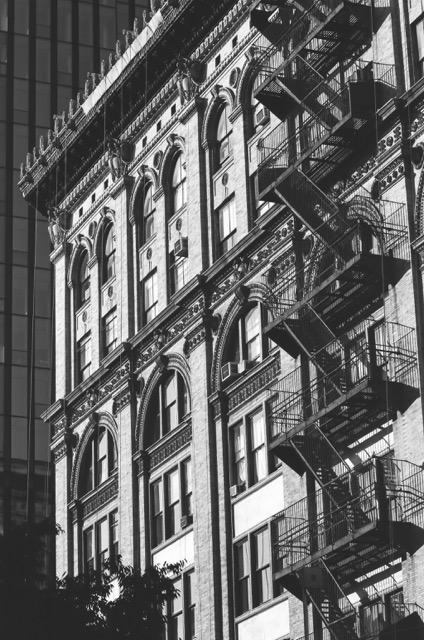
This image offers a perspective of a New York building, with the fire escape creating a grid of shadow and metal. The interplay between the old architecture and modern surroundings is captured nicely, showing Ferrania P30’s capability in delivering strong contrasts while maintaining delicate details in the mid-tones and highlights.
Film Characteristics: Excellent shadow detail and smooth tonal transitions, making Ferrania P30 a standout and one of my favorite black-and-white films for architectural photography in urban settings.
Chrysler Building Spire
The iconic Chrysler Building’s spire shines in this image, shot against a clear sky. Ferrania P30’s ability to capture fine details is evident here, with each layer of the building’s Art Deco design standing out crisply. The gradient from the spire to the sky remains smooth and clean, showcasing how well this film handles high-contrast scenes.
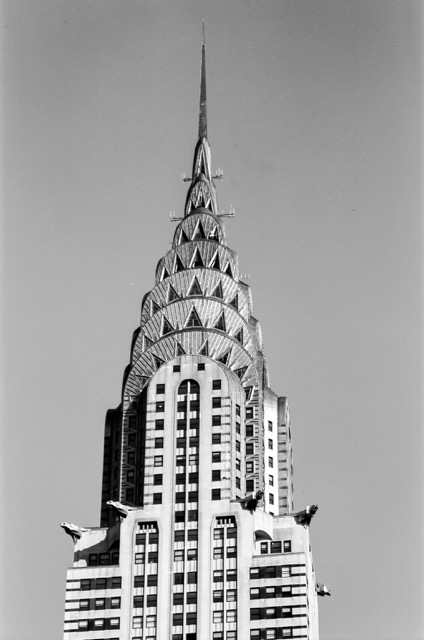
Film Characteristics: Fine grain and exceptional sharpness, especially in highlights and intricate architectural features. The tonal range provides rich detail without losing subtlety.
Rounded Dome and Ornate Detailing
The final image showcases a dome-topped building with exquisite ornamentation. Ferrania P30 captures the grandeur of the structure, rendering the ornate details of the stonework with stunning clarity. The light falling on the dome highlights its texture, while shadows add dimension to the shot, creating a classic look reminiscent of early 20th-century black-and-white photography.
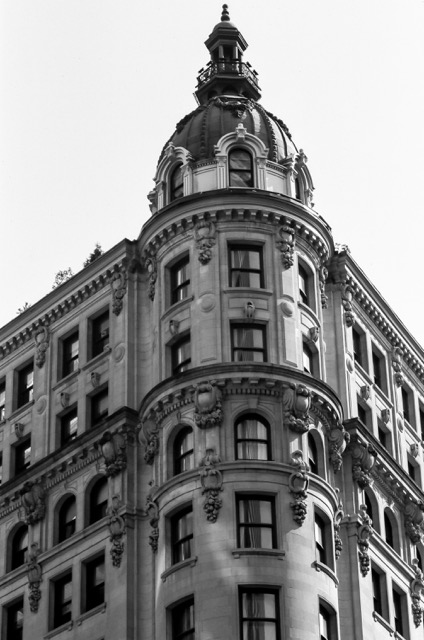
Film Characteristics: Subtle highlight rendering and rich blacks, making this an ideal film for capturing fine architectural elements with a timeless feel.
These photos demonstrate Ferrania P30’s remarkable ability to capture both the grandeur and intricacies of New York City’s architectural gems, making it an excellent choice for cityscape and architectural photography.
Ferrania P30: The Pros and Cons
Pros:
- Cinematic Quality: With its high silver content, P30 produces a cinematic look, perfect for urban environments.
- Fine Grain: Despite being a 80 ISO film, it retains excellent detail without becoming too grainy, which is crucial for capturing architectural shots.
- Contrast and Depth: The film’s contrast levels are superb, particularly in high-contrast scenes like cityscapes with dramatic lighting.
Cons:
- Low ISO: As a 80 ISO film, shooting Ferrania P30 demands good lighting or slower shutter speeds. It isn’t the best option for low-light photography unless you’re willing to push it, which can add more contrast and grain than you might prefer.
- Limited Exposure Latitude: P30 can be unforgiving in overexposed scenes. Shadows are rich, but highlights can be blown out more easily than with more modern films.
Final Thoughts
Ferrania P30 is not just a film—it’s an experience. Its high contrast and deep blacks make it perfect for dramatic cityscapes, while the fine grain ensures that even intricate architectural details are beautifully preserved. If you’re looking to add a touch of classic film elegance to your street photography or architectural shots, Ferrania P30 won’t disappoint.
Whether capturing New York’s towering skyline or the quiet solitude of Central Park, this film brings out the best in the scene. It’s a film that demands attention and intention—and rewards you with striking, timeless images.
Some additional sample photos from NYC – Ferrania P30
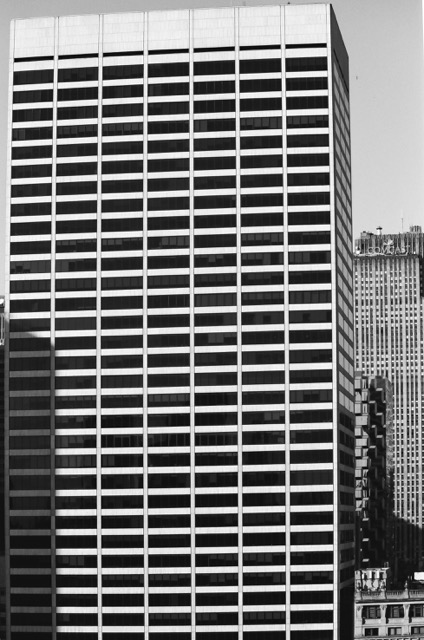
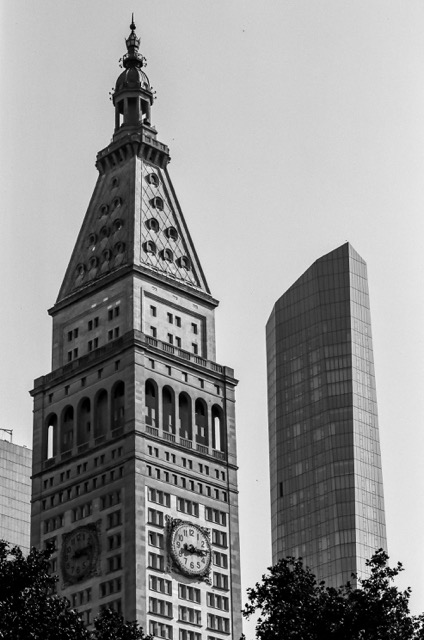
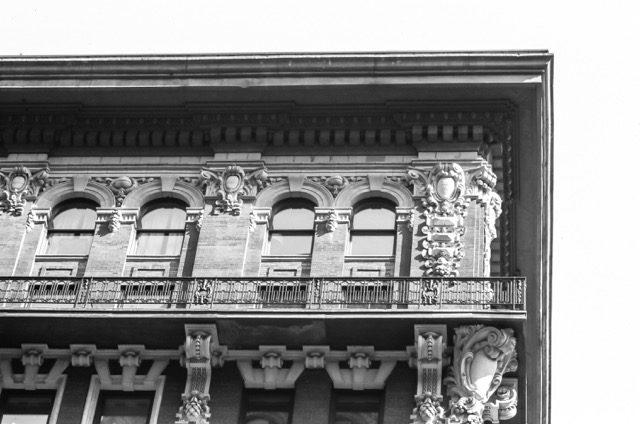
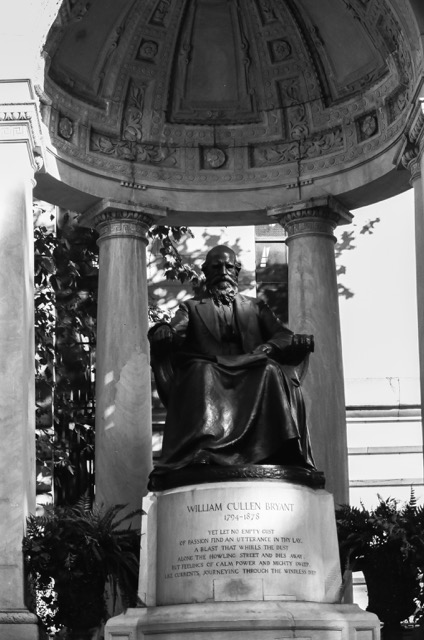
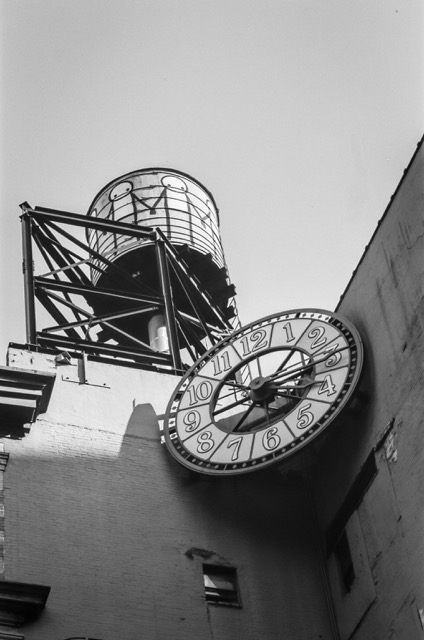
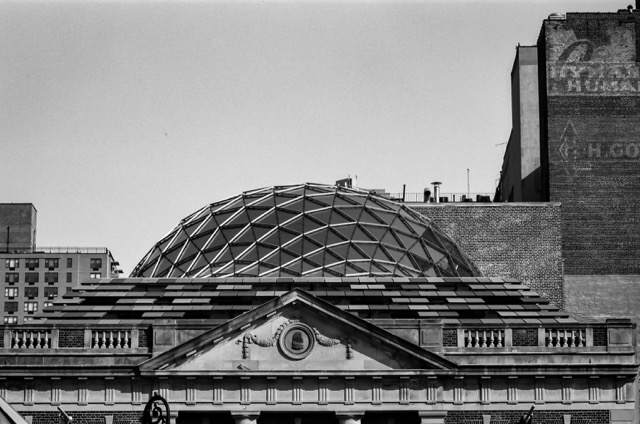
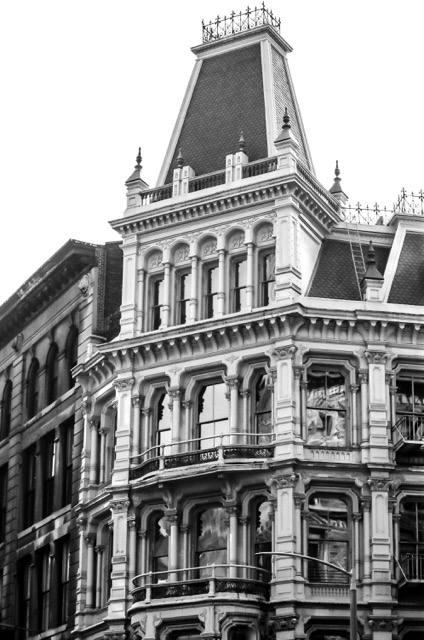
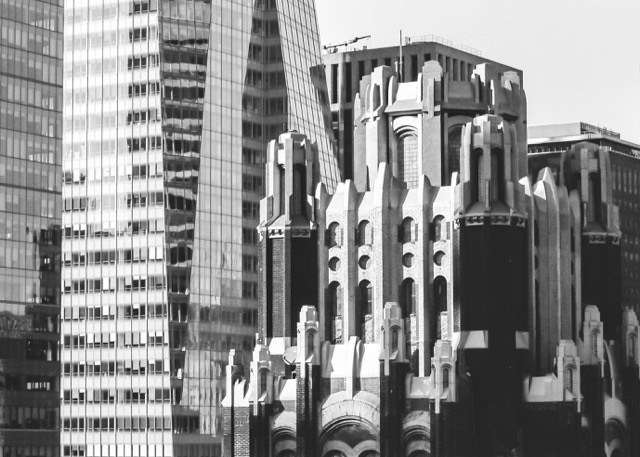
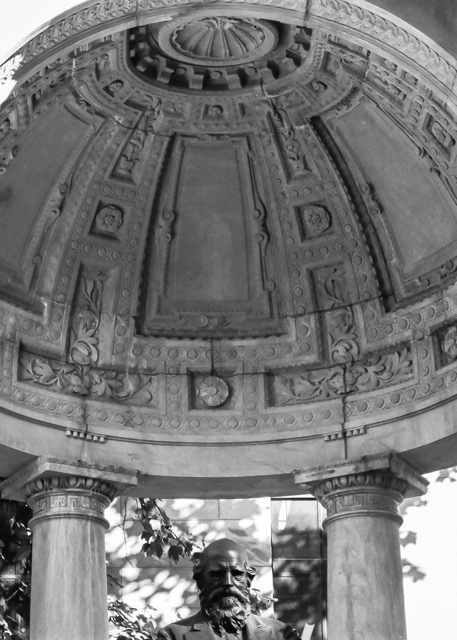
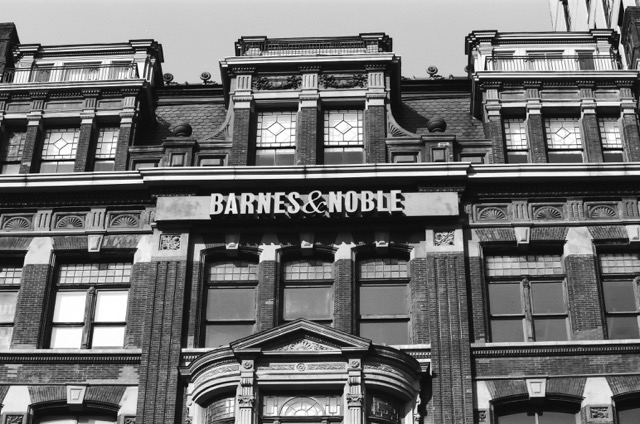
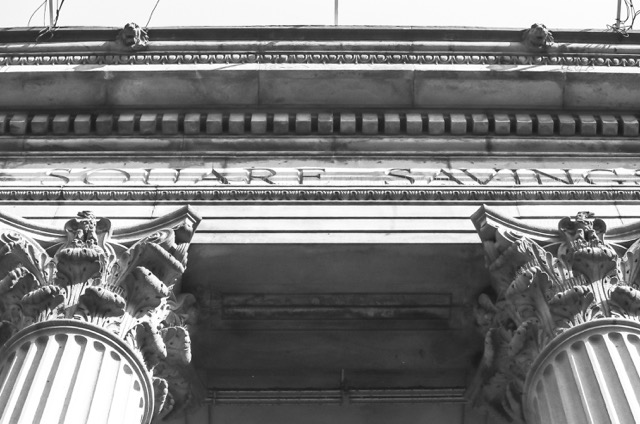
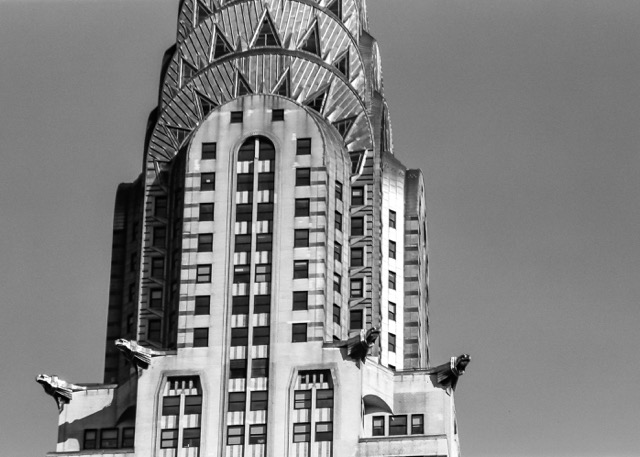
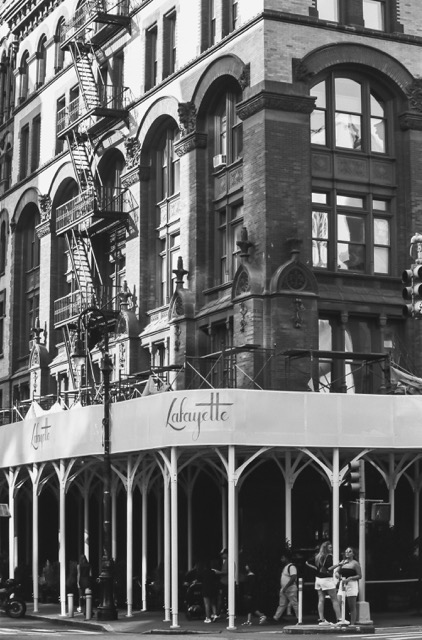
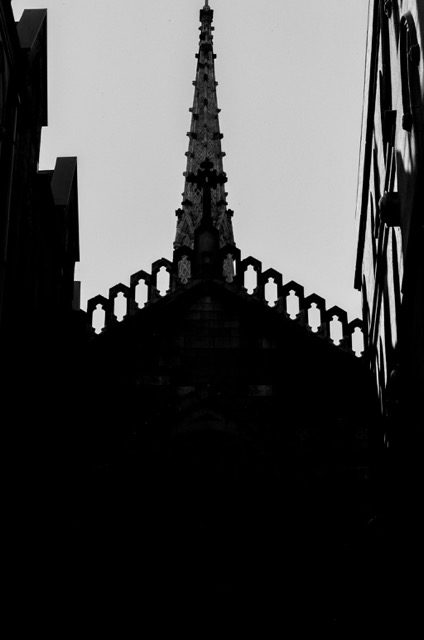
Some More Advanced Tips for Shooting Ferrania P30
For medium to advanced photographers, Ferrania P30 offers a great platform to push your skills, experiment with light, and refine your shooting techniques. Here are some tips to help you get the most out of this unique black-and-white film:
Use Zone System for Precise Exposure
- Advanced photographers can leverage the Zone System to manage Ferrania P30’s exposure latitude. Metering for specific zones of your scene—such as placing shadows in Zone III or highlights in Zone VII—can help you get the exact tonal range you want. This technique is especially useful given P30’s limited exposure latitude.
- Since P30 can easily blow out highlights, metering carefully for the most critical parts of your image will allow you to capture detail in both shadow and highlight areas.
Push and Pull Processing
- Ferrania P30 is a film that responds well to push processing, especially if you need to shoot in lower light. Pushing to ISO 160 or even 320 can introduce more grain and contrast, but it also adds a gritty, cinematic quality that can be perfect for street or night photography.
- Conversely, pull processing Ferrania P30 (exposing it at ISO 50, for example) can help flatten the contrast slightly, giving you more control in bright or high-contrast situations. This technique works well for scenes with harsh sunlight or reflective surfaces.
Master Light and Shadow Play
- Ferrania P30’s high silver content gives you the ability to create dramatic, deep blacks. Use this to your advantage by seeking out high-contrast scenes—such as buildings with long shadows or subjects partially illuminated by natural light. The interplay between light and shadow will be amplified, providing you with striking imagery.
- Backlighting can also be an exciting approach. With Ferrania P30, backlit subjects maintain detail without washing out, offering a soft glow with pronounced shadows.
Experiment with Textures and Surfaces
- P30’s fine grain makes it ideal for photographing highly textured surfaces—such as rough concrete, rusted metal, or weathered wood. Look for scenes where the surface details can tell a story. The film’s tonality and fine detail will emphasize these textures beautifully.
- Consider shooting objects with reflective surfaces like water, metal, or glass to explore how the film handles reflections and highlights. This can give your work a distinctive, polished look.
Dynamic Range Control with Filters
- Since P30 can be high-contrast, filters can help control exposure in challenging lighting conditions:
- Use yellow, orange, or red filters to deepen skies and create more pronounced cloud separation in landscape or cityscape shots.
- A green filter can enhance foliage contrast while maintaining natural brightness in architectural scenes or portraits shot outdoors.
- For more dramatic mood and texture, try a polarizing filter to cut through reflections and further intensify contrast in bright light.
Shooting for Grain vs. Fine Detail
- Depending on your subject matter, choose whether you want to emphasize fine detail or embrace the grain. At ISO 80, Ferrania P30 gives you very fine grain, perfect for architectural photography or portraits that require subtle gradations. However, if you push it to ISO 160 or ISO 320, you’ll introduce more grain, which can add a vintage or gritty feel to street scenes or artistic projects.
- Think about how grain affects the mood of your image and use it to convey emotion, atmosphere, or narrative.
Architectural and Long Exposure Photography
- Ferrania P30’s fine grain and sharpness make it an excellent choice for architectural photography. Use long exposures to capture building details and movement, like clouds or water, against static structures. This film retains detail well over extended exposures, but keep an eye on highlights, as they can easily blow out in long exposures.
- For long exposure night photography, consider using a neutral density (ND) filter during the day to extend your exposure time while maintaining control over highlights and shadows. This can help you achieve smooth, artistic motion effects.
Street Photography with Mood and Drama
- P30’s inherent contrast and tonality are a fantastic match for street photography, especially in urban environments. Look for gritty, dynamic scenes where contrast plays a key role—neon signs, alleyways, wet streets reflecting light, or bustling markets can be great subjects for P30’s look.
- Experiment with angles that amplify the film’s drama—low angles that stretch shadows or compressed perspectives that emphasize patterns can enhance the cinematic feel of your shots.
Capture Mood in Portraits
- While not the most traditional choice for portraiture, P30 can produce striking, moody portraits. Its sharpness and contrast will emphasize facial features and expressions. For a softer, more ethereal look, slightly overexpose by 1/3 or 2/3 of a stop to bring more light into the highlights, creating a glowing effect without losing shadow detail.
- Consider pairing portraits with interesting backgrounds that play into P30’s strengths—old brick walls, textured fabrics, or outdoor settings where natural light adds dimension to the subject’s face.
Embrace Film’s Imperfections
- As a more advanced photographer, you can use Ferrania P30 to embrace the imperfections of film photography. Whether it’s light leaks, grain, or even slight underexposures, these “flaws” can enhance the character of your shots. Ferrania P30’s vintage, cinematic qualities are amplified when you lean into its raw, sometimes unpredictable results.
- For added creativity, intentionally overdevelop or underdevelop your film during processing. This can add unexpected shifts in contrast or tonality, giving your work a unique aesthetic that digital photography simply can’t replicate.
Post-Processing with Scans
- When scanning your negatives, be mindful of how you handle post-processing. Ferrania P30’s rich blacks and contrast can be further enhanced or toned down in post-production, depending on the mood you’re trying to achieve.
- For a cinematic feel, you may want to retain high contrast and rich blacks, but if you prefer a more balanced, fine-art look, adjust the curves to soften shadows or reduce highlights.
Ferrania P30 is an advanced film that allows for sophisticated control over light and contrast. Its cinematic quality and rich tonal range offer endless opportunities for experimentation, whether you’re shooting dramatic cityscapes, fine art portraits, or textured close-ups. By embracing its unique characteristics and pushing your creative boundaries, you can achieve results that go beyond the ordinary.